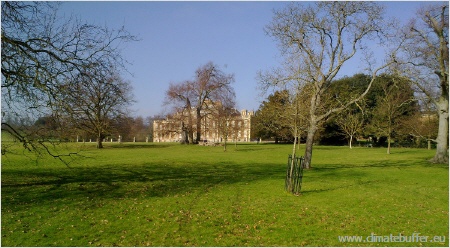Wimpole Estate
Carbon management on Wimpole Home Farm
The Home Farm is historically a ‘demonstration farm’ and in 10 years the aim is to restore it to a true Demonstration Farm, self-sufficient in energy, water and food.
Firstly, the efficiency of current energy use (electricity) was investigated. See the chart which identified use by the different sectors of the estate, and stimulated major reductions in the heaviest use.

The Wimpole Estate
(Photo: Katherine Hearn, National Trust)
As part of the Wallington research project [6.516 KB]
intensive soil carbon sampling was carried out on the Wimpole estate in 2009, and a soil carbon map produced. The ‘CALM’ (Carbon and Land Management) carbon calculator tool was used, and the farm became 1 of 200 trial farms for carbon management.
A calculation showed that the parkland, with permanent grassland and trees, was sequestering 700t of C, whereas the arable land was emitting a similar amount. Otherwise the tool had limitations – it does not account for carbon implications of management, e.g. the energy used in fertiliser production. It was decided to concentrate on actions on the ground, and to aim for the arable land carbon budget to equate to that for grassland.
A decision was made for the farm to go organic. Straw, FYM and compost are now being regularly used to increase the organic matter content of the soils. However, it is clear that organic matter alone will not raise the quality of the soils – the whole soil structure has been damaged by past contract farming. The soils are heavy, 40% clay, and need to be treated extremely carefully. The OM had fallen to a low level and the structure was very poor. A ‘soil structure index’ was used, reflecting the clod structure and root penetration. An ‘earthworm challenge’ was undertaken – holes were dug across the farm, and worms counted per hole. Very few holes had worms. Structure and worm numbers appeared to be closely linked.
The Defra Soil Protection Review (a Cross Compliance requirement) will be made into an active management document. As well as OM addition, there will be much attention to compaction; tractors will have minimal compaction effect, eg a tracked tractor with 600mm wide tyres will have an impact of 7 psi rather than the more normal 16psi (and the machine used for lifting straw bales has a pressure of 50psi, so this will never go into the fields now).
Agri-schemes (Entry Level and Organic Entry Level Stewardship) will benefit the farm.
One year later the number had increased so already the management appears to be improving the soil. (In Holland, soil plugs from well-structured sites with abundant worms are ‘grafted’ into damaged sites.)
The project started in 2010 and was finished in 2012.